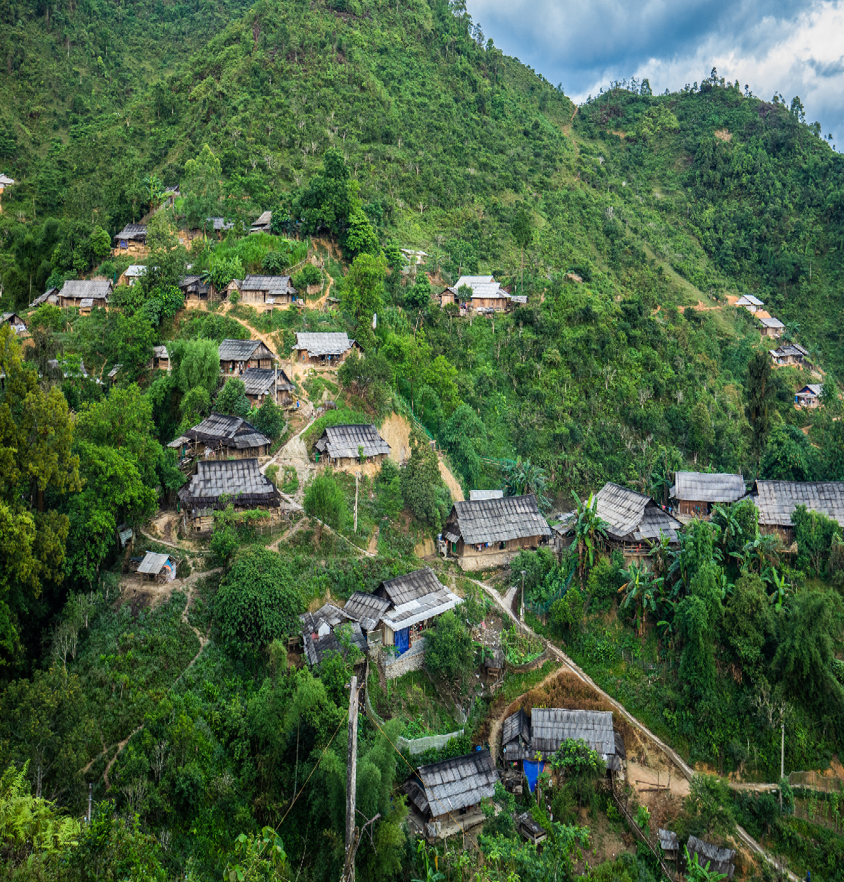MinChou - Special Shan Tea
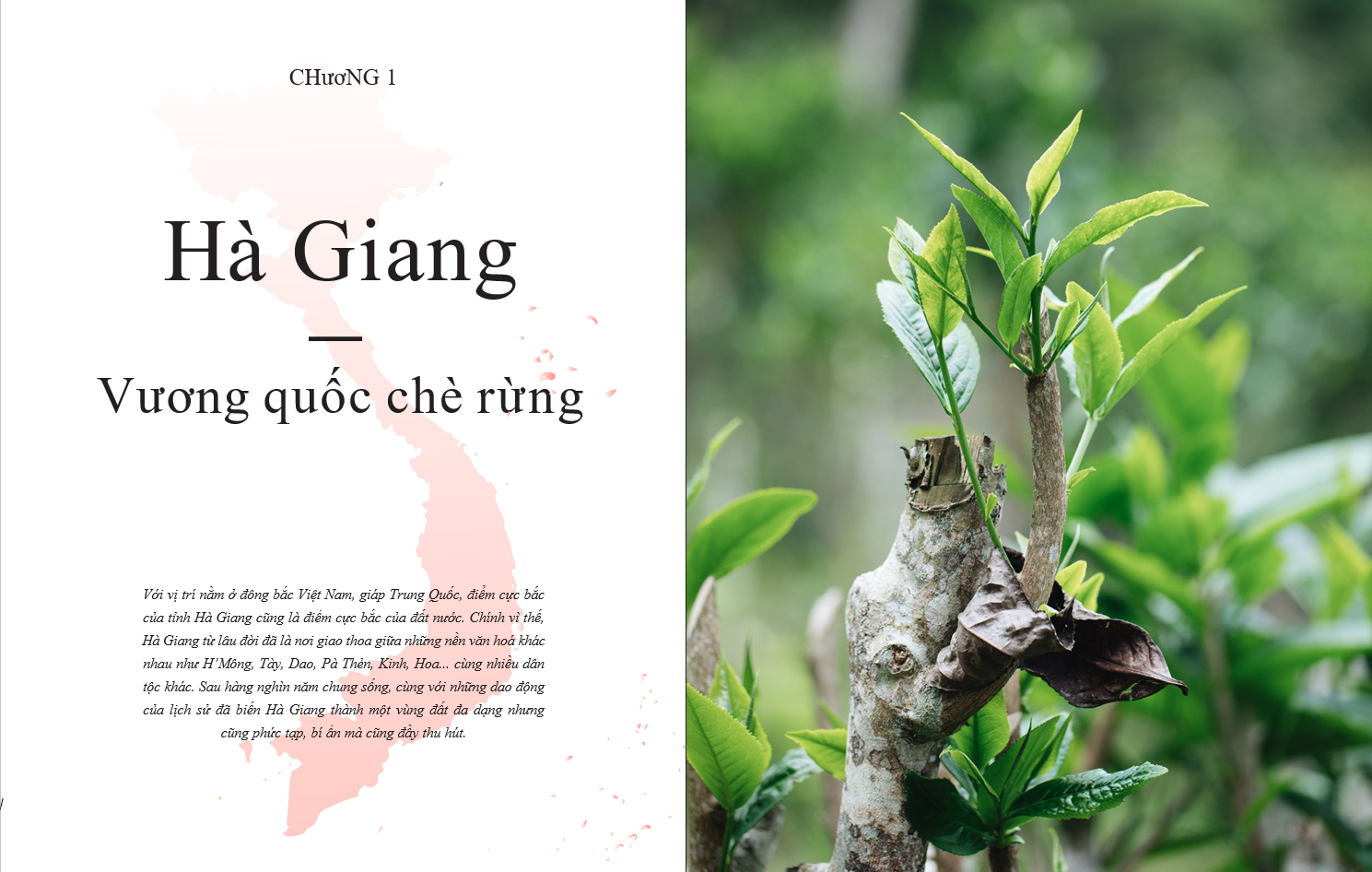
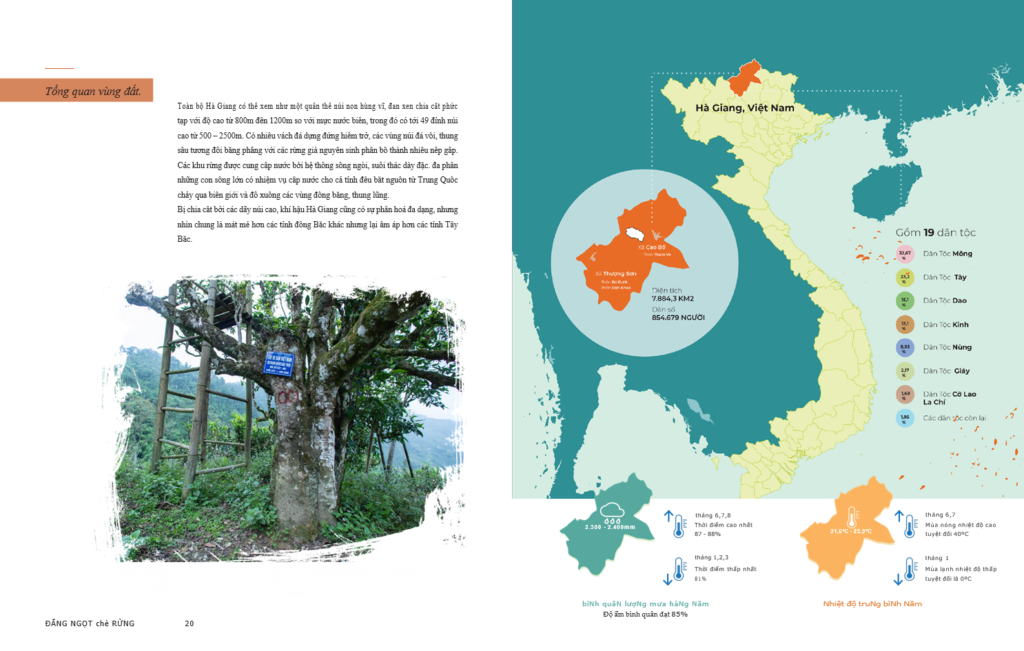
Part 1
Exploring the Depths of Chiêu Lầu Thi
To kick off our journey to explore Ha Giang’s forest tea, we visited Hồ Thầu commune in Hoàng Su Phì district, situated just beneath Chiêu Lầu Thi peak, home to Bạch Tiên tea and Móng Rồng tea (as locally known). These two unique tea varieties from Vietnam and the Ha Giang mountains have gained recognition from the global tea community. At an altitude of 2402m, standing side by side with Tây Côn Lĩnh peak, Chiêu Lầu Thi is the second-highest peak in northeastern Vietnam. In rapidly changing weather conditions, where mist can immediately turn into harsh sunlight, the temperature can vary by up to 10ºC throughout the day.
Due to these conditions, the tea forests of Chiêu Lầu Thi, at an altitude of 1700m above sea level, have adapted over thousands of years to the harshness of the land and sky, resulting in unique tea varieties with exceptional flavors that cannot be found elsewhere.
Bạch Tiên tea is characterized by its red-purple young leaves, large buds, long snowy hairs, and very low caffeine content. This rare tea variety grows naturally only in places with special weather conditions.
Starting from the center of Hồ Thầu commune, we traversed over 20 kilometers of treacherous mountain roads by car to reach Tân Minh hamlet. Then, we continued an additional 10 kilometers on motorbikes, navigating muddy stretches and rocky sections to approach Chiêu Lầu Thi peak. It was a challenging route, testing both endurance and courage for those wanting to witness the precious tea forests.
Throughout our challenging journey, we noticed a common pattern for these precious tea varieties. Regardless of altitude, the older the tea forest, the higher the quality, making it increasingly difficult to access. During our expedition, the team had to pass through breath-taking and sometimes impassable routes, often requiring us to get off the vehicle and walk due to the extreme difficulty.
Tea seems to choose secluded places to concentrate its essence into each flower, branch, and leaf. Therefore, it’s not surprising that tea plants often choose high mountainous areas with mist and wind to develop extensive root systems, enhancing the aroma and flavor over the years. Good tea tends to grow in dangerous places, and rare tea lives in deep and rugged locations.
Guiding us was Mr. Triệu Văn Mềnh, a Dao ethnic artisan, renowned for tea in Ha Giang. Mr. Mềnh is the person who discovered the natural habitat of Bạch Tiên tea around Chiêu Lầu Thi peak.
According to his story, for decades, people of the Dao and Tày ethnic groups in the area have been harvesting Bạch Tiên tea alongside other Shan snow teas. Only later, during the tea processing at the factory, did Mr. Mềnh notice the peculiarities in color and flavor in each tea bud.
From that serendipity, he inquired with many people, climbed the treacherous “nine-level staircase” to find the unique population of Bạch Tiên tea. These tea trees, over 500 years old, grew amidst the lush greenery, unknown to humans. Some trees reached 20-30m in height, with branches touching the clouds. Due to their perilous location and towering height, harvesting Bạch Tiên tea is extremely challenging. Local residents, each time they harvest this tea, spend two days sleeping in the forest and drinking spring water. Because the tea trees are too tall, reaching the young leaves with buds is very risky. The tea on the highest branches is almost impossible to harvest. Each kilogram of Bạch Tiên tea embodies the value of one of the rarest teas in the world, accompanied by countless difficulties in the local residents’ harvesting efforts. The tea bundles, arriving at the processing place, seem to have raced against time while being filled with extreme hardship.
From these precious raw materials, through the skilled hands of Mr. Mềnh, the finished Tiên tea has gained fame worldwide, recognized by international friends. Mr. Mềnh shares, “The processing of Bạch Tiên tea requires attention to preserving the inherent flavors in the tea buds.”
Therefore, the tea buds need to be naturally air-dried under the sun and winds of Ha Giang, minimizing the intervention of machinery. Perhaps due to this intricacy and meticulousness, Bạch Tiên tea retains the fragrance of the mountain forest, an embrace of honey scent, along with a refined taste—subtly bitter yet lingeringly sweet—harmoniously blending in a cup of tea.
It is precisely this delicacy that has attracted many tea enthusiasts worldwide to Ha Giang, conquering Chiêu Lầu Thi and experiencing the ethereal realm of tea.
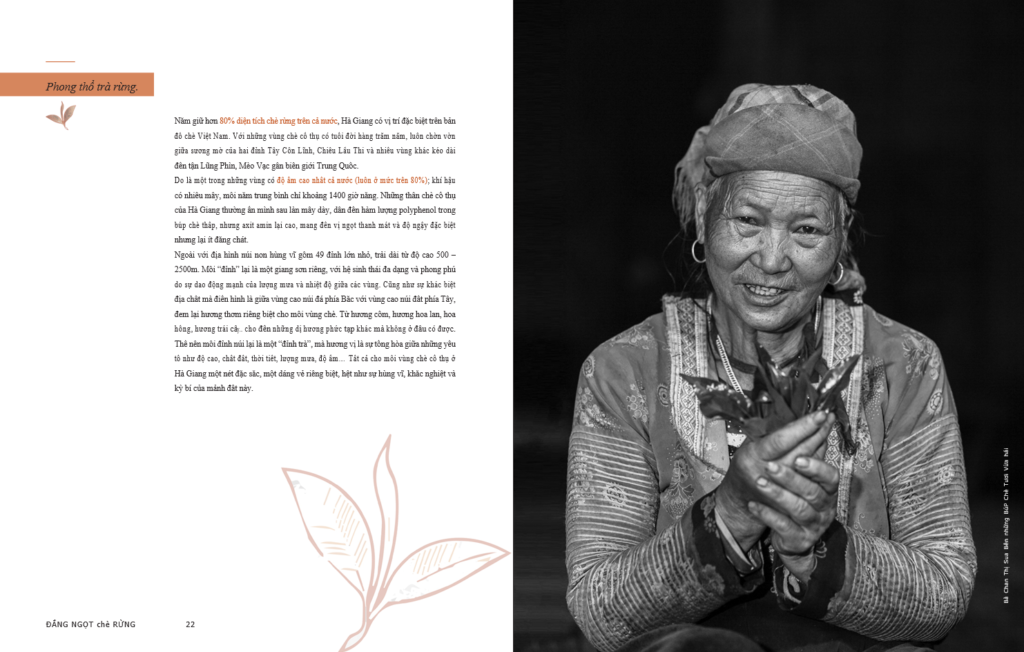
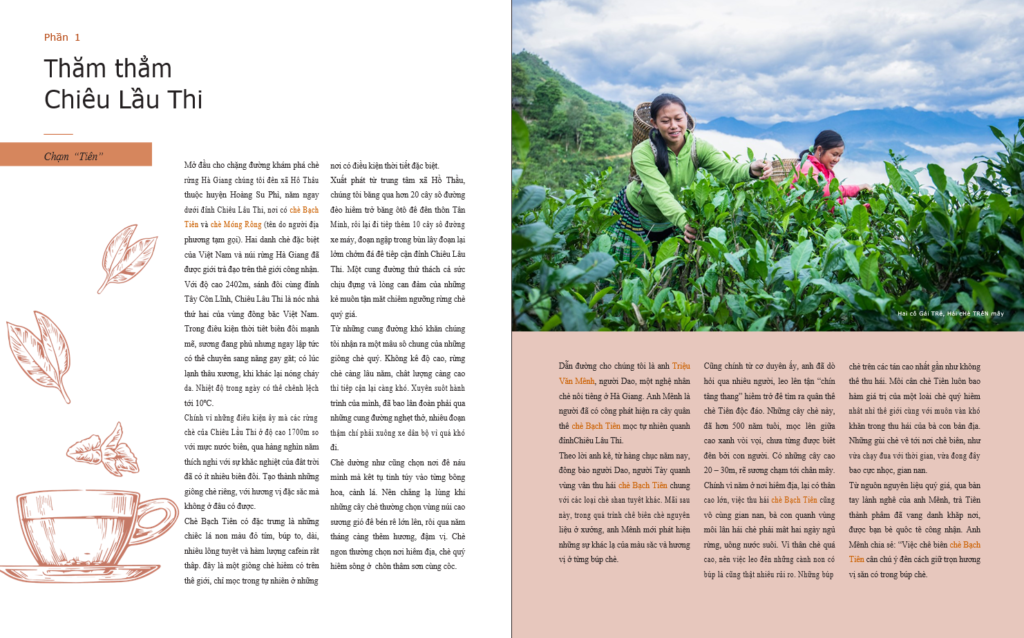
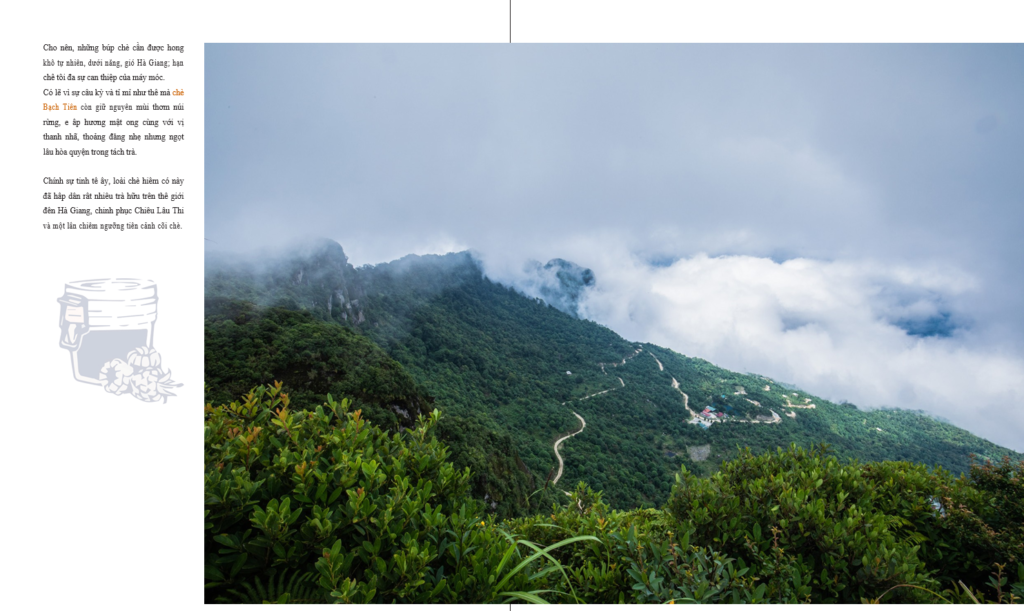
Following in the footsteps of Mr. Mềnh, we left the Bạch Tiên tea forest and traveled about 4-5 kilometers at the same altitude to reach the Móng Rồng tea community. Móng Rồng tea is a peculiar variation that is still not well-known, and there are no specific research projects on it at present. The Móng Rồng tea tree is about 2-2.5 meters tall, with smaller, less serrated leaves than those of common tea varieties. The branches of the tree spread widely, somewhat drooping, and the young leaves have a yellowish tint.
Although still not thoroughly explored by science, Móng Rồng tea is known to be a precious tea variety in China since ancient times. The tea buds of Móng Rồng are called Yabao in Chinese, meaning “newly sprouted buds,” where Nha means “sprout” and Bao means “outer covering.” This name reflects both the unique appearance of Móng Rồng tea buds and its distinctive features compared to regular tea buds. From one Móng Rồng tea bud, branches and two to three young green leaves will sprout.
Despite being a precious tea variety, this tea was not known in the past, partly due to the distinctive shape of the tree and leaves, as well as the strange appearance of the tea buds. We speculate that this is also the reason why, until now, only tea enthusiasts have discovered the flavor of “Móng Rồng.”
In contrast to Bạch Tiên tea, harvesting Móng Rồng tea is not too dangerous, as the tea trees are only 2-3 meters tall, with wide and low branches. However, due to the nature of Móng Rồng tea buds, there is no concept of “one bud, one leaf” or “one bud, two leaves.” Locals often harvest the entire sprout growing from an older branch, resulting in a very limited quantity. This significantly reduces the yield per tree compared to regular tea varieties.
To harvest one kilogram of Móng Rồng tea, it takes one hour – two to three times longer than the time required for regular tea harvesting. The growth period of the tea bud is also longer than that of the tea leaf, so for Móng Rồng tea, only two harvests can be made each year.
In recent times, local authorities have had to limit the harvesting of Móng Rồng tea to once a year to preserve the ancient tea forest and prevent excessive exploitation, which could lead to the depletion of the tea trees. This policy has contributed to the conservation of this precious tea variety and brought sustainable benefits to the local community.

